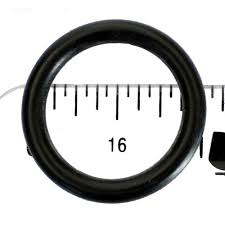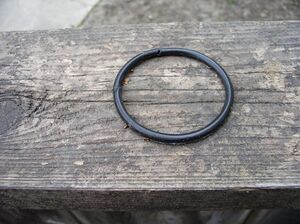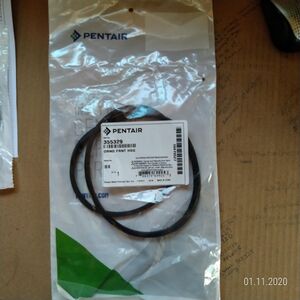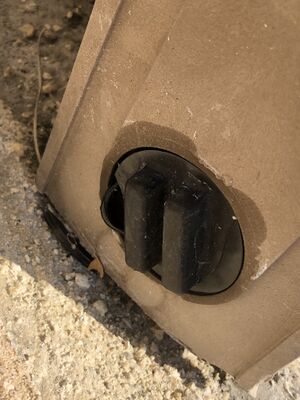O-Rings
O-rings are used throughout a pools plumbing to create watertight seals. You find large O-rings sealing the joints of filter to small O-rings sealing rotating valve stems. O-rings also create watertight seals around threaded fittings and unions. O-rings are in pumps, filters, heaters, chlorinators, valves, actuators, and unions. Just about anyplace two surfaces come together and has water you will find an O-ring sealing the joint.
An O-ring is a doughnut shaped ring molded from an elastomer.
The basic core polymer of an elastomeric compound is called a rubber, produced either as natural gum rubber in the wild, on commercial rubber plantations or manufactured synthetically by the chemical industry.
Swimming pool pump and filter o-rings are typically made with EPDM rubber, while chlorinator o-rings are usually made of a Fluorocarbon, Viton or FKM. Many O-rings we see in pools are Buna N 55 hardness. Buna is one of the most widely used O-Ring elastomer compounds and is a Nitrile compound. The actual name is Acrylonitrile-Butadiene and can be referred to as Buna, Nitrile or NBR. Buna has heat resistance up to 212F (100C) and cold flexibility down to between -30F and -70F depending on compound.
For more details about O-Rings see the Parker O-Ring Handbook
O-Rings? O-Yeah! How to Select, Design, and Install O-Ring Seals is a great video about O-Rings.
O-Ring Wear and Tear
O-Rings may last 5 to 10 years, they don't last forever. O-Rings will often wear out and need replacement before the equipment does.
Ozone, weather and atmospheric aging can make O-Rings brittle and lose their flexibility. O-Rings in rotating shaft seals in pumps, valves, and actuators can wear from the friction of the shaft movement.
If a threaded joint develops a drip suspect that an O-Ring needs to be replaced.
When inspecting an O-Ring look for:
- small cuts, nicks or gashes, typically from installation damages.
- ragged edges which appear tattered, typically due to excessive clearances.
- blisters, pocks, or pits on its surface, due to rapid pressure changes.
- radial cracks located on the highest temperature surfaces. In addition, certain elastomers may exhibit signs of softening due to exposure to excessive heat.
- signs of degradation including blisters, cracks, voids or discoloration, due to chemical incompatibility.
- circumferential splits within the flattened surface, usually due to excessive compression.
- a flat surface parallel to the direction or motion. Loose particles and scrapes may be found on the seal surface, due to friction from a rough sealing surface.
Below is an O-Ring that was nicked and damaged:
O-Ring Sources
Check the Installation Manual for your equipment to find the manufacturers O-Ring part numbers.
Many O-rings are a commodity and can be found at hardware stores for much less then when packaged by a pool company. The advantage to paying pool company prices is you know you are getting the correct size O-Ring with the required materials.
O-Rings, Inc. is a leading online supplier of quality O-Rings.
allorings has a O-Ring Size Chart - AS568 Standard O-Ring Sizes that finds AS568 o-ring standard sizes by cross section, inside diameter and outside diameter in our O-ring size chart and separate O-ring tolerance chart.
Aladdin Equipment Company, Inc. makes many of the O-Rings and GO-KITs manufacturers use. Note that Aladdin has their own proprietary O- numbering standard for O-Rings that is different then the AS-568 standard.[1] Aladdin has a Parts Cross Reference on their website.
Tightening O-Rings
O-rings sit in a groove (or gland) and seal through compression. Any joint sealing with an O-ring should not be over-tightened. Over-tightening an O-ring joint can deform the O-ring and lead to leaks. Generally, fittings with o-rings only need to be "hand tight." You might need a wrench to loosen such a fitting, but you shouldn't use a wrench to put it back together if you can avoid it. If your hands are not strong enough to tighten a fitting enough, then you can gently use a wrench, but only to make the fitting a bit more snug than you could with your hands. You don't crank the fitting down.
If a fitting with an O-ring is leaking do not simply crank it down to try and stop the leak. That can crack the union, or pipe, or further deform the O-ring. Open up the joint and examine the O-ring for nicks, cracks or deterioration. Replace the O-ring if it is damaged or has lost its flexibility and is deformed.
Below shows a filter drain plug that was overtightened and the O-ring deformed:
O-Rings Need to be Lubed
All O-rings seal better when Pool Lube is used on them. Pool Lube should be used on all new O-rings and small leaks can often be stopped with an application of Pool Lube.
O-ring lube allows the three surfaces involved (the ring and the two components it's sealing together) to slide together as you tighten things up.[2] Without it, the O-ring will pinch and bind and deform. It's the deformation that causes the leaks. And the premature wear. So the [Pool Lube|lube]] is not really adding to the sealing properties of the O-ring, rather it allows the O-ring to retain its correct shape and do its job. And in that way it can lengthen the O-ring's life. Cleaning the O-ring and the surfaces it touches is important because a chunk of dirt can also deform the O-ring and cause a leak.





